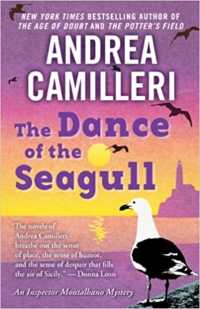|
While this danse
macabre is the key to the through-line in Camilleri's narrative, the plot
is immediately driven by the disappearance of Fazio, Montalbano's main capo, a
steady-as-she-goes cop that you've become familiar with from the previous
novels, which personalizes the crisis for both the Inspector and the reader. To
be sure it's a police fiction cliché, yet here it's just a fact, and the
tension builds as you realize that Fazio has been abducted, perhaps killed, as
his mission at the port of Vigàta was unofficial, and his colleagues
don't know what he was up to. Seems he was helping out an old school friend, a
former ballet dancer, who has suspicions about goings on with the fishing fleet
and a certain warehouse that he has been observing through a telescope from his
apartment. Turns out this man, this dancer -- Manzzella -- is a habitual
voyeur, enjoys spying on his neighbours, and since he left his wife, is now
taking a walk on the wild side.
Here the story might
remind you of The Crying Game, Neil Jordan's 1992 film about transsexual love
and terrorism, but only distantly, as a shared exoticism rather than a formula
theft. There are several very good scenes along the way, especially when
Montalbano follows a tip that Fazio was seen struggling with two men in 'the
territory of the dry wells" at Monte Scibetta, a known Mafia body dump. This
sequence produces a couple of bodies, then ends up in an abandoned highway
tunnel. Darkness, amnesia, and bullets -- can anything good come from any of
this?
'Without anyone
noticing, Montalbano superstitiously touched his balls to ward off bad
luck'
'The night was soft
and clear and windless. And the moon, instead of resting over the orchards, was
floating on the sea'
At one juncture,
Montalbano visits a murder house, moves like a somnambulist through the moonlit
rooms reconstructing the crime. It's a nightmare, a seance for detectives and
madmen with the art of remote viewing. The house stinks of death, is a theatre
of torture and sadism. This self-hypnosis induces seeing through blindness, a
trap for coincidence and fate. It's occultism and Montalbano knows it, despises
himself for indulging the ritual, this taboo possession with its grotesque
voyeurism and shabby exorcism. But he sees it all, the two torturers shooting
their victim in the foot, then forcing him to dance, to flutter until he dies.
Then they take a shower. Why?
'To cleanse
themselves for human society as humans, not as the beasts they
were'
There's no question
that this is one of Camilleri's best Montalbano novels because, even though
many of the characters and the situations remain the same, the story runs
against the grain, is anti-romantic. Montalbano is 57 here, 'in the twilight of
his career', and the issues and crimes he deals with really have no happy
resolution. He has a romance with a blonde, sure, but it's a vulgar exercise in
political sex, not love. He uncovers a heinous crime of international
significance, but it isn't something the government can admit, let alone
punish. He does stage some local justice, but you know it's tabloid, not
institutional.
You might wonder -- as
Camilleri has a lot of experience teaching theatre direction -- if this novel
owes anything to Chekov's play The Seagull (1896). In this symbolist drama,
which was avant garde for the times, the seagull is a gift to a young actress
from a crass suitor who shot the bird because he had nothing better to do. But
the actress prefers a visiting writer who thinks the incident would make an
excellent short story. This sort of internal aesthetic commentary anticipates
the post-modern fashion of blurring the alienation wall between the author and
his characters... a technique Camilleri engages occasionally in the Montalbano
series. And towards the end of The Dance of the Seagull, Montalbano indeed
wonders how "Camilleri" is going to get him out of the situation he finds
himself in. So, you could say there's an oblique influence, intellectual rather
than story-wise, where Camilleri has borrowed a symbolic motif, adapting it for
his own design.
As I've said before
elsewhere, Andrea Camilleri is a major writer, regardless of genre. He walks
with beauty.
© LR April
2017
*Check out LR's
OUTLAW
ACADEMIC »»
or LR's novel
RADIO
BRAZIL »»
|
